Judith A. Yates's Blog, page 6
November 18, 2019
Stealing English bulldogs Now A Lucrative Crime
Jennifer Bramlitt allowed her two dogs outside for a “potty break,” including English bulldog “Chug.” She walked away to get their usual treat when she heard a car door slam. In less than 60 seconds, Chug was stolen out of the rural home’s yard. He is not the only stolen bulldog in a lucrative crime of English bulldog theft.
 Jennifer and her husband, Robert, live in West Point, Kentucky with their two dogs, including “Chug.” Although both dogs were together, the other dog was not stolen. Robert, who is a United States Army veteran, spends every spare moment following leads, driving for miles and web surfing for hours looking for Chug.Some unscrupulous professionals assist in dog theft across the country. For unusual, expensive, and popular breeds, some veterinarians, grooming shops, and other professional dog caregivers sell lists of owner’s names and addresses to thieves. Theft rings may have “lookouts” to spot the breed. If the stolen bulldog is neutered or spayed, thieves will either resell the dogs to unknowing buyers or use them in dogfighting as bait or fighters.
Jennifer and her husband, Robert, live in West Point, Kentucky with their two dogs, including “Chug.” Although both dogs were together, the other dog was not stolen. Robert, who is a United States Army veteran, spends every spare moment following leads, driving for miles and web surfing for hours looking for Chug.Some unscrupulous professionals assist in dog theft across the country. For unusual, expensive, and popular breeds, some veterinarians, grooming shops, and other professional dog caregivers sell lists of owner’s names and addresses to thieves. Theft rings may have “lookouts” to spot the breed. If the stolen bulldog is neutered or spayed, thieves will either resell the dogs to unknowing buyers or use them in dogfighting as bait or fighters.
 In 2015, Robin Harrington was taking photos of “Dotty” in her yard behind her locked gate when she had to go inside the house for a few minutes. Robin had no worries – she lived in a wooded area far from neighbors. When she returned to the yard, “Dotty” was gone. Law enforcement located a spot in the woods where the thief had conducted a prolonged surveillance of the house.Theft of this breed can turn dangerous for owners. Another English bully was stolen from a Seattle man with disabilities, making national news: the gentleman was walking his bulldog when three people roared up beside him in a car, shoved him to the ground, and stole the dog. The dog was found running in the street where it is believed the thieves cut him loose when they felt the pressure of exposure. And Kristi Baucum’s puppy, Trudy, was stolen from her at gunpoint. The thief was caught, but too afraid of repercussions from his accomplices to tell police the dog’s location. Trudy is still missing.
In 2015, Robin Harrington was taking photos of “Dotty” in her yard behind her locked gate when she had to go inside the house for a few minutes. Robin had no worries – she lived in a wooded area far from neighbors. When she returned to the yard, “Dotty” was gone. Law enforcement located a spot in the woods where the thief had conducted a prolonged surveillance of the house.Theft of this breed can turn dangerous for owners. Another English bully was stolen from a Seattle man with disabilities, making national news: the gentleman was walking his bulldog when three people roared up beside him in a car, shoved him to the ground, and stole the dog. The dog was found running in the street where it is believed the thieves cut him loose when they felt the pressure of exposure. And Kristi Baucum’s puppy, Trudy, was stolen from her at gunpoint. The thief was caught, but too afraid of repercussions from his accomplices to tell police the dog’s location. Trudy is still missing. Trudy, stolen at gunpoint. She will be an adult now.
Trudy, stolen at gunpoint. She will be an adult now.If you have information contact truecrimebook@
yahoo.com. No questions asked, Reward!The American Kennel Club lists English bulldogs as the fourth most popular breed in the country. English Bulldog owners will confirm; this is neither a “typical dog” nor the type that is kept out of the family circle. The Bulldog Club of America notes, “Constant learning, a knowledge of genetics and inheritance, familiarity with health issues, and understanding pedigrees is essential,” and “it is important (owners) … have a veterinarian who is knowledgeable and has experience with Bulldogs.” These are “man-made dogs,” says one experienced bulldog owner. Once used as butcher’s dogs to subdue animals for slaughter, they have been “bred and crossed with other types of dogs” to acquire the look of today’s “bully.” Thus, they are prone to many health issues, including breathing, stomach problems, rickets, and “cherry eye.” Most are on medication. Females must have cesarean births. Many bullys are turned in to rescues or dog shelters because these adorable puppies grow into high-maintenance, stubborn, expensive animals. If bred well and treated right, English bullys are loyal, guarding property with aggressive-sounding barks but turning into “big babies” for tummy scratches and treats.Tessa Houck’s “Goobie” was one of those “big babies.” The Houcks live in a quiet neighborhood in Morgantown, North Carolina. One June evening of 2016, she let her English bulldog “Goobie” out
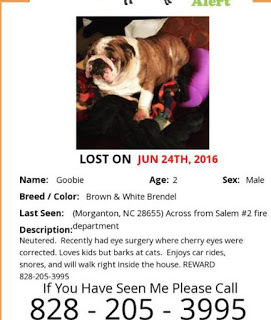 into her backyard for his “potty break.” Goobie was outside for perhaps ten minutes. Tessa had no worries as a high privacy fence with a locked gate surrounds her yard. But in that short amount of time, “Goobie” was stolen. She immediately performed a detailed search of the area but he was gone. Its possible neighbors stole him; he may be in West Virginia. She still searches for him, hoping someday her loving big, goofy dog will come home.There is a Facebook team of “web sleuths” working together to help locate the stolen dogs and to share information on suspicious persons and vehicles. Losing a family dog is heartbreaking, and having that pet stolen can be worst. Besides flyers and ads with information on Chug, Robert and Jennifer Bramlitt posts a plea:To the person who took our boy PLEASE BRING HIM HOME!! I will put a leash at the end of our driveway (YOU KNOW WHERE) and you can come in the middle of the night and leash him up there. Just PLEASE bring him back to us. Our family is broken without him. I am BEGGING you please bring our boy back. He needs medication and special food and WE NEED HIM !!!!!
into her backyard for his “potty break.” Goobie was outside for perhaps ten minutes. Tessa had no worries as a high privacy fence with a locked gate surrounds her yard. But in that short amount of time, “Goobie” was stolen. She immediately performed a detailed search of the area but he was gone. Its possible neighbors stole him; he may be in West Virginia. She still searches for him, hoping someday her loving big, goofy dog will come home.There is a Facebook team of “web sleuths” working together to help locate the stolen dogs and to share information on suspicious persons and vehicles. Losing a family dog is heartbreaking, and having that pet stolen can be worst. Besides flyers and ads with information on Chug, Robert and Jennifer Bramlitt posts a plea:To the person who took our boy PLEASE BRING HIM HOME!! I will put a leash at the end of our driveway (YOU KNOW WHERE) and you can come in the middle of the night and leash him up there. Just PLEASE bring him back to us. Our family is broken without him. I am BEGGING you please bring our boy back. He needs medication and special food and WE NEED HIM !!!!!If you have any information on these dogs, please contact truecrimebook@yahoo.com. Generous rewards are offered with no questions asked.
Published on November 18, 2019 20:14
November 11, 2019
The most evil female serial killer you may have never heard of
At the corner of 10 East 21st Street in Tulsa, Oklahoma, there is what used to be a parking lot. There is a set of old stone steps leading off the lot into the street. These steps are the remnants of one of the most evil female serial killers you may have never heard of: Carolann Smith.It is difficult to truthfully record all of Carolann’s history of crime; not much is known about her before, during, and after her crimes. And her list of potential victims wasn’t unearthed ...until law enforcement found the two captives in her basement…Opal Mary Carey was from Indianapolis, Indiana. She was using the name Carolann Mary Smith when her husband Fay H. lost his job about 1934. Sometime in 1934, Fay was found dead with his face blown off and a shotgun
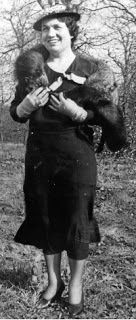 Carolann Smith liked living the
Carolann Smith liked living the high life (Tulsa World File)nearby. None of his friends or former coworkers thought he was suicidal, but Carolann and Fay had discussed in depth his suicide as an option to end their financial woes. It left Carolann with a $31,000 payoff. The landlord was not a fan of Mrs. Carolann Smith, so he raised the rent just to get her out. The ploy worked and the 51-year-old widow packed up and moved into a bigger duplex, a lovely brick home at 10 East 21st Street near Main in Tulsa, Oklahoma. At the time, perhaps it didn’t seem strange. Or maybe it was just a coincidence or foul play that could not be proven. But wherever Carolann went, people dropped dead. The investigator working Fay’s suicide case died. Carolann’s sister also passed during this time period. The records as to cause of death no longer exist.Carolann decided she wanted her father to move in with her. He resided in St. Louis. She invited him, telling him the duplex was just too big for her alone. He agreed, and she made several trips to help him pack and get his affairs in order. One of those affairs was to take out an insurance policy naming her as the beneficiary. Her father never made it to Tulsa; he died. Carolann collected a nice lump of cash by way of an insurance payoff. No one person could put all of these deaths together and find an unusual pattern. While Carolann Smith was planning all of these funerals, the officiant who had to organize them also died. Carolann Smith was living in the 21st street duplex in February 1935 when a woman burst out of the door and ran screaming across the lawn. She ran down the few stone steps blindly into the street where she was struck by a car. The victim was rushed to the hospital but succumbed to her injuries days later. Carolann told investigators that the poor woman’s name was Beulah Walker, a nurse that worked in Carolann’s home. Multiple efforts were made to reach Beulah Walker’s family to no avail; Carolann told the investigators she would be happy to handle that. After all, Beulah Walker had a large insurance policy and Carolann was the beneficiary. But when she was sitting in the insurance office, Carolann told them Beulah was her beloved - and wealthy - aunt, which created a higher payout. The insurance company didn’t buy it. They investigated and discovered poor Beulah was a lowly servant who Carolann treated like a dog and paid crumbs. The company canceled the policy. All was not over, however: the man who was driving and killed Beulah was dead soon after. It is said he was tight-lipped about this very shady incident.
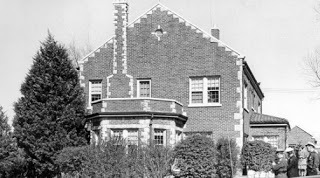 Side view of 10 East 21st St. in Tulsa, OK circa 1944.
Side view of 10 East 21st St. in Tulsa, OK circa 1944. The balcony from where Carolann supervised the
dog's burials. (Tulsa World File)Then came Carolann’s craziest and most deadly scam. It was the one that would put her in the annals of crime history.
Thirty-one-year-old Virginia Evans was from a prominent family in Stroud, Oklahoma. She had the misfortune of meeting Carolann Smith in 1937 at a Christian Science bookstore. The two women struck up a friendship. After a year or so, Carolann asked Virginia to move in with her, which she happily did.
Seven years later, Virginia would say she was “hypnotized and mesmerized” by the older woman.Thirty-year-old Willetta Horner met Carolann at grocery store, where they talked occasionally. Willetta eventually told Carolann about her bad childhood. Later, Willetta would say she and Mrs. Smith had a “mother-daughter” relationship. She also thought Carolann adopted her when she moved in at the duplex. It was wartime, which means items across the United States had to be rationed. Families were meted out ration books, which were used to purchase certain items. When the ration stamps were gone, the family had to wait until they received another book. The bigger the family, the more ration stamps they received.
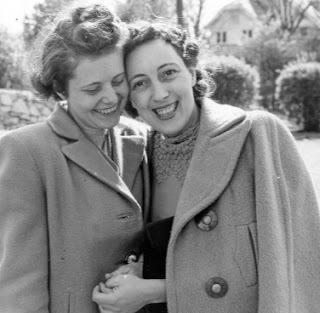 Virginia Evans and Willetta Horner were kept
Virginia Evans and Willetta Horner were kept as slaves for seven years (Tulsa World File)Carolann had expensive tastes. That would explain why she dressed in the latest fashions, drove a shiny new Packard. One ration book was not going to do it for her. She needed cosmetics, shoes, and accessories to go with her nice clothes. So she applied for seven ration books, stating six were for her children and dependents. In reality, she had no children that lived past infancy. The two “dependents” were her roommates, Virginia and Willetta. Three of the books were issued in the names of Fay H. Smith, Carolann’s father, and Beulah Walker. One was issued to her eleven-year-old nephew Bobby, who Carolann wrote down as a resident in her home. “Bobby” was actually “Bonbon,” Carolann’s bulldog. This is where Carolann made mistake #1: screwing over the government. The Rations Board felt this was a suspicious case, so they turned it over to the local police department to investigate. The Tulsa police began interviewing neighbors, and they got an earful – enough to get a search warrant on 10 East 21st Street, especially when a neighbor reported seeing two women burying coffins in the backyard by the light of the moon, with Carolann Smith overseeing the project from her balcony. Then those crazy screams and growls coming from their apartment at all hours…The graves turned up to hold dog remains, to include “Bobby” / “Bonbon.” It was inside the house where the most horrific sights awaited.
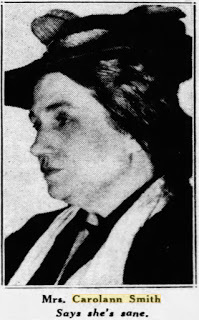 From The Post, 1944Virginia Evans and Willetta Horner was being kept in the basement like neglected dogs, allowed out only to work. They washed in the cold water of an industrial mop sink, slept on crates, and had little food. Their clothing was filthy. They wandered about like little zombies for Carolann, cooking, cleaning, working at her whim. They cleaned and took care of her 18 pairs of gloves, 26 hats, and over 200 pairs of shoes. Virginia and Willetta went to their jobs every day but turned over every cent they made to Carolann. They had also relinquished every bit of their savings. They did hateful things to neighbors, they fought one another, and they had left their own families and never tried to escape or report what was happening inside the walls of the house, all per CarolAnn's rules. And they had existed like this for seven long years.Carolann had created her own religion and carefully studied mind control and brainwashing techniques. She had Virginia and Willetta convinced that if they did not follow Carolann’s orders, they would be doomed to hell. Like all cult leaders, she was using religious teachings with her spin, charisma, isolation, fear, and intimidation. “She put a hex on us,” One of the captives told law enforcement. That got to the press. The house will forever be known as “The Hex House.”
From The Post, 1944Virginia Evans and Willetta Horner was being kept in the basement like neglected dogs, allowed out only to work. They washed in the cold water of an industrial mop sink, slept on crates, and had little food. Their clothing was filthy. They wandered about like little zombies for Carolann, cooking, cleaning, working at her whim. They cleaned and took care of her 18 pairs of gloves, 26 hats, and over 200 pairs of shoes. Virginia and Willetta went to their jobs every day but turned over every cent they made to Carolann. They had also relinquished every bit of their savings. They did hateful things to neighbors, they fought one another, and they had left their own families and never tried to escape or report what was happening inside the walls of the house, all per CarolAnn's rules. And they had existed like this for seven long years.Carolann had created her own religion and carefully studied mind control and brainwashing techniques. She had Virginia and Willetta convinced that if they did not follow Carolann’s orders, they would be doomed to hell. Like all cult leaders, she was using religious teachings with her spin, charisma, isolation, fear, and intimidation. “She put a hex on us,” One of the captives told law enforcement. That got to the press. The house will forever be known as “The Hex House.”
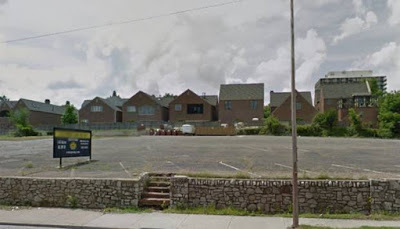 10 East 21st St. in Tulsa, OK today. Note the original stone steps in front.Carolann had bilked money out of Virginia’s father, telling him Virginia was ill and needed special care. He began sending money to pay for her care. And Willetta’s mother came to Tulsa looking for her daughter, only to wind up dead. Carolann Smith had taken out insurance policies on both Virginia Evans and Willetta Horner a month before the women were found; they were probably found just in time. As the investigator dug further into her past, they found the trail of death Carolann left in her wake, none of which could be proven. In October of 1944, Carolann Mary Smith AKA Opal Mary Carey was found guilty of inducing Virginia Evans and Willetta Horner to testify falsely against a neighbor. She was sentenced to one year in prison. In November 1944 she pled guilty to purgery, mail fraud, obtaining money under pretenses, and using false statements to obtain a ration book (for Bonbon); she received probation. “In my opinion, I’m sane,” she told the court. Upon release from prison, Carolann left Oklahoma and disappeared from the public eye. The “Hex House” at 10 East 21st Street was destroyed in 1975, the basement filled in. It was a parking lot for a while and tales circulate of it being haunted. The old stone steps Beulah Walker ran down into the street are still there, the only witness to one of the most evil female serial killers you may have never heard of, Carolann Smith.
10 East 21st St. in Tulsa, OK today. Note the original stone steps in front.Carolann had bilked money out of Virginia’s father, telling him Virginia was ill and needed special care. He began sending money to pay for her care. And Willetta’s mother came to Tulsa looking for her daughter, only to wind up dead. Carolann Smith had taken out insurance policies on both Virginia Evans and Willetta Horner a month before the women were found; they were probably found just in time. As the investigator dug further into her past, they found the trail of death Carolann left in her wake, none of which could be proven. In October of 1944, Carolann Mary Smith AKA Opal Mary Carey was found guilty of inducing Virginia Evans and Willetta Horner to testify falsely against a neighbor. She was sentenced to one year in prison. In November 1944 she pled guilty to purgery, mail fraud, obtaining money under pretenses, and using false statements to obtain a ration book (for Bonbon); she received probation. “In my opinion, I’m sane,” she told the court. Upon release from prison, Carolann left Oklahoma and disappeared from the public eye. The “Hex House” at 10 East 21st Street was destroyed in 1975, the basement filled in. It was a parking lot for a while and tales circulate of it being haunted. The old stone steps Beulah Walker ran down into the street are still there, the only witness to one of the most evil female serial killers you may have never heard of, Carolann Smith.
Published on November 11, 2019 07:41
November 6, 2019
The Pleasant Hill School Bus Tragedy - On the plains of 1931 eastern Colorado, a small busload of children survive a heinous winter’s storm
 The bus after it was emptied of children. Notice the back is filled with snow because of the missing windows.
The bus after it was emptied of children. Notice the back is filled with snow because of the missing windows. The children boarding the makeshift school bus were singing and laughing. They had been let out of school early and were planning on being under a gorgeous blue sky, not inside a humdrum schoolhouse learning sums. When the last child settled onto the bench, the engine of the 1929 blue Chevrolet roared to life. Excited kids giggled and waved to the kids boarding the second bus, thinking of the adventures to come. What they could not fathom was the horrors that would follow. It was Thursday, March 26, 1931, and the date is a part of morbid Colorado history called the “Pleasant Hill School Bus Tragedy.”Pleasant Hill, located in Kiowa County, eastern Colorado, was a farming community on the plains, made livable by hardworking folks who believed in honesty, hard work, and helping your neighbor. Only one of the farmhouses had a telephone in March 1931, and none of the homes had electricity. Families survived on little and what they did have, they shared: if a farmer butchered a hog, it was separated equally between neighbors. If someone’s chickens lay better than other’s, eggs were divided. The children were raised with the same ethics; no strangers to hard work: milk cows, pump water, gather eggs, and help around the home, all before it was time for school. 1931 had a bitter winter, where attic windows burst open from howling winds and filled with snow. So when March 26 opened under beautiful blue skies, it felt like springtime had come. Some children eschewed coats for school. Others donned light sweaters. Sure, clouds were forming in the distance, but it was a beautiful day.Farmer Carl Miller picked up the children on his driver’s route. During the summer, he used his blue 1929 Chevrolet for hauling hay. During the winter it served as one of the two school buses for Pleasant Hill School, and he made extra money as a driver. Carl’s bus was one of two routes; one ran east, the other ran west. There were two rough-hewn wooden benches in the back for 20 kids to share, with enough room to store their metal lunch pails under the benches on the floor. The back windows were missing, so Carl had placed cardboard inside the frames. The truck was about the size of today’s minivans. Carl Miller greeted each child as they boarded the bus. In this small community, everyone knew each other. He most likely asked each child about their families, general questions. While it was polite to discuss generalities, it was not considered proper to share feelings or voice private matters.School started in the one-room Pleasant Hill schoolhouse, but the two teachers compared notes and watched the dark clouds welling up, appearing just as quickly as their students piled into seats. By the time class started, the snow was coming down heavily. Gone was the promise of an early spring.There was no food or blankets stored in the school. The students had their lunch, but no other means of sustenance. It was determined everyone should go home. The announcement was met with much happiness from the student body.As quickly as they had exited, now the students boarded the buses. As the norm, they placed their lunch pails under the benches on the floor of the bus. Carl Miller fired up the blue Chevrolet and they were on their way. But the snow was falling thicker and faster. Carl called out to his passengers to try to look out the windows to help navigate. Their usual route became a blanket of white, and it was near impossible to find the dirt road. Carl decided it best to take a short cut. It would cost him, and several of his passengers, the highest price.It took only fifteen minutes for the driver to become lost. Forty-mile an hour winds pushed the heavy snow against the old truck. Ice now coated all of the windows. The snow and wind blew out the rear window’s cardboard covers. And when Carl attempted to turn the bus, the rear wheels slid into a ditch and refused to move. Carl did not know it at the time, but the bus was one mile from the schoolhouse and a half-mile from the closest farmhouse. By now the weather created a total whiteout.But the children were oblivious. Bad weather and danger were just a part of life. They sang and laughed, still talking about spending the day in a warm house. Their bus driver had to explain to them that the bus was not moving. It was at about 9:30 a.m.The children’s ages ranged from eight to sixteen. The two oldest, a boy and girl, bundled up to go look for help. As they disappeared out the door, Carl kept the youngsters busy by having them do jumping jacks, shadowboxing, and dancing about. He was hoping it would keep their body temperatures up. It wasn’t long before the boy and girl returned, breathless. The storm had slammed them back. The weather was just too horrific. The children were becoming exhausted with all the movement; they just couldn’t play or exercise any longer. Their lunch pails had frozen to the floor of the bus, so there was no food. Exhaustion set in on the little bodies. They tried a game where they slept in short shifts, where they took turns calling out to one another. Now snow had piled to the roof in the back of the bus. And the weather had not let up. The first to die was a little girl whose body had given out. The oldest girl carried her to the back of the bus to cover her gently with snow.To keep warm, the children decided to sleep in a big pile. But hypothermia set in, and they began shedding clothing. One little girl had worn a yellow sweater to school that day, a recent gift that she had wanted to show her classmates. When she died, she was also carried to the back of the bus. The night brought bitter cold, total darkness. “My daddy will come get us,” one little boy kept promising. “He always says if I’m in trouble, he’ll come get me.” On Friday morning, March 27, Carl Miller decided that he would go for help. He had put his coat around a little boy who had not worn a coat to school; now he had to take it back. He put the oldest two kids in charge. “Don’t worry,” he winked at the group of worried little faces. “I’ll be back. And we’ll have pancakes for breakfast!” They never saw him again.Worried parents kept peering out windows and doors to look for their children. Finally, the men of the house began hitching horses up to wagons to venture out. The storm was still blowing, but the horses were hearty farm creatures and the men were determined. When they reached the schoolhouse, the chills they felt were probably colder than the icy winds.The schoolhouse windows were blown out and snow had piled up inside. Long icicles hung from the ceiling. But no children were in sight. As the day wore on, the storm was finally releasing its hold. The blue bus could be spotted in the ditch. One of the men leaped from his wagon to fight fifteen-foot snowdrifts. When he fought the bus door open, he could only say, “Oh, what a sight.”It was at about 5:00 p.m. The children had been in the bus for 33 hours. The first two men to enter the bus found their children dead from the cold. Carl Miller’s child was also deceased.The living children were rushed to a nearby farmhouse. They suffered from frostbite and hypothermia. One boy died before they could all be taken to a local hospital. Because of farmhouse remedies, none of them lost any limbs or toes. The ones who made it to the hospital survived, but their first night was filled with screams. There was so much pain – physical and psychological.The dead children were buried while their classmates remained in the hospital. A search party had found Carl Miller lying in the snow, arms raised above his head, staring up at the sky. He had managed to walk three miles before collapsing. His gloves and hands were torn and bloody from feeling along a barbed-wire fence. Six died as a result of the Pleasant Hill School Bus Tragedy: five children and Carl Miller.No one received counseling during this time in history. Life was tough, and people had to be tough. When bad things happened, people dealt with it. One did not share feelings or private matters. Death was a part of it all. Until the media got hold of the story and it blew up all over the country. The children became national heroes. What the media didn’t know about the tragedy and its people, the media made up until the story grew. One circus asked one of the boys to join them on tour. The kids traveled to Denver courtesy the Denver Post newspaper and were treated to new, free clothing and fancy dinners. Farm kids who had never seen the inside of a restaurant were now seated at tables with fine china and linen tablecloths. Country boys and girls who grew up in hand-me-downs and a single pair of shoes now owned closets full of clothing that would be too nice to wear anywhere they would ever go. In a public relations maneuver, one boy met the President of the United States. They were all awarded medals for heroism.But once back home, no one talked about the bus tragedy. Much later, the children as adults and their much - older families would share their struggles with PTSD, survivor’s guilt, severe depression, and flashbacks with few people. They could never forget, and they would never recover.As a result of the Pleasant Hill School Bus Tragedy, Colorado State Legislators would pass local and national laws to make schools and school transportation safer. This included painting school buses a bright yellow so they could be easily seen in inclement weather, a practice that continues today in most parts of the U.S. In 1962 a granite stone memorializing the School Bus Tragedy was erected. It sits directly between the towns of Towner and Holly in a desolate part along what is now blacktop highway. This blacktop highway was once a dirt road where a lost bus driver and twenty children met fate.
Note: The incident is also referred to as “The Towner-Holly School Bus Tragedy” References Children of the Storm: The True Story of the Pleasant Hill School Bus Tragedy. (2001). Harner, A & Seacrest, C. Fulcrum Publishing Co.Speer, J. Director & Writer. (2016). “Pleasant Hill School Bus Tragedy.” United States. Colorado Experience.Unknown. (March 28, 1931) Five Children Freeze in Eastern Slope School Bus. The Daily Sentinel, Grand Junction, Colorado. P. 1
Published on November 06, 2019 20:56



